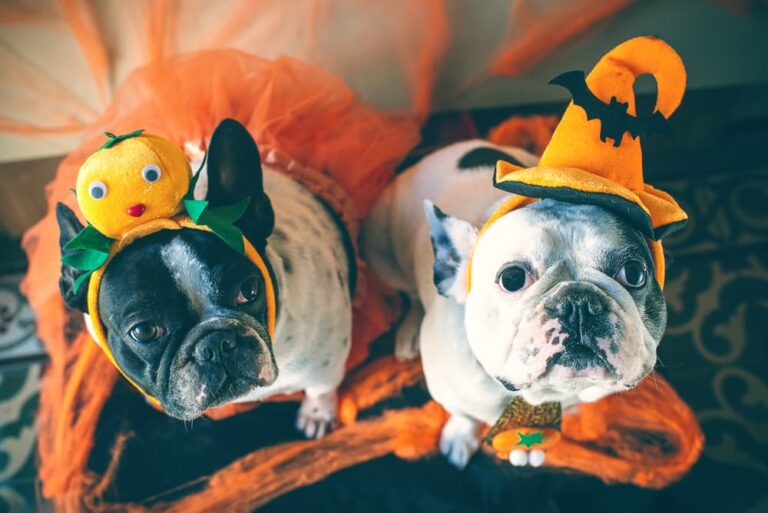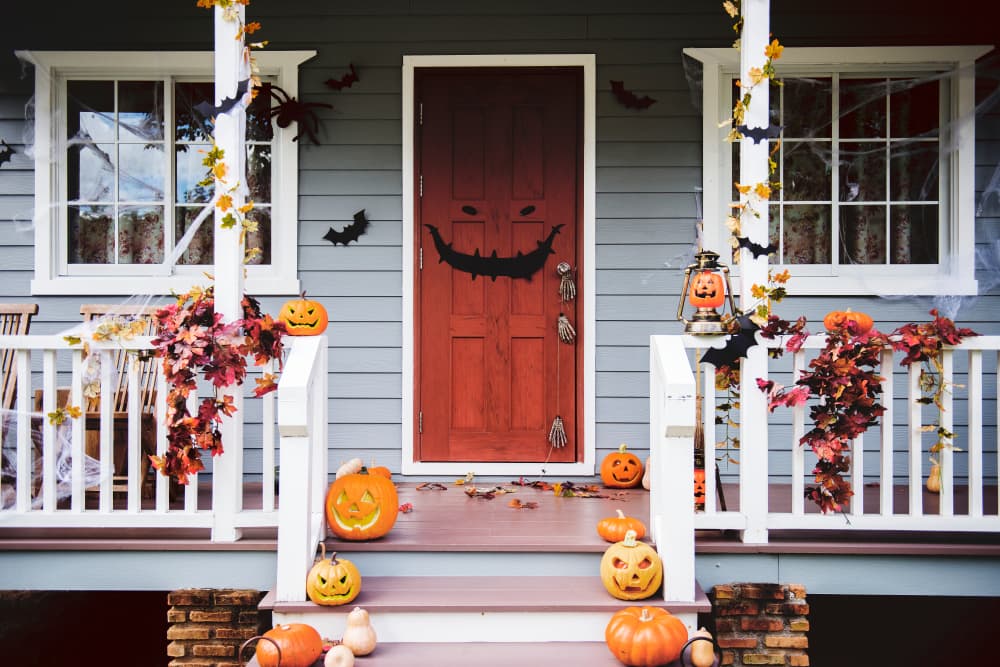9 Scary and Surprising Halloween Dangers for Pets

In addition to ghosts and goblins, Halloween presents plenty of scares for pet parents. From tempting candy treats to hazardous décor to problematic pumpkins, Halloween dangers for dogs and cats are lurking in the shadows—and sometimes in plain sight!
To enjoy all the fun without the fright, consider these Halloween safety tips for pets.
Pet Costumes

Just about everyone loves animals in costumes. One notable exception? Many animals. While some cats and dogs will happily play dress up, expect others to be less enthusiastic about that elaborate pirate getup.
“Watch for signs of stress or anxiety when dressing your pet in costume,” advises Dr. Ari Zabell, a veterinarian at Banfield Pet Hospital. “Don’t force him or her to wear it. A simple accessory, such as a bandana or bowtie, can be a nice compromise.”
If your pet tolerates a costume, make sure it doesn’t limit movement, hearing, eyesight, or the ability to eat food or drink water. Avoid any outfits with small parts that could present choking hazards, and ensure it’s not too snug or too loose.
Chocolate

In general, Halloween candy and dogs aren’t a great mix. Chocolate in particular contains theobromine, a substance that can be poisonous for pets, explains Dr. Sharon L. Campbell, a veterinarian at Zoetis.
“The main thing to watch out for is the amount of theobromine a dog might eat. The darker the chocolate, the more theobromine,” says Campbell. “As a rule of thumb, the more bitter the chocolate tastes, the darker it usually is, and therefore the worse it is for dogs.”
Signs that your pet may have eaten chocolate include hyper-excitability and anxiousness, seizures, abnormal heart rhythms, rapid breathing, vomiting, and diarrhea, she adds.
If you believe your dog ate candy, call your veterinarian immediately, advises Campbell. Raisins can be extremely toxic to pets even in small amounts, so seek emergency care if chocolate-covered raisins go missing.
Artificial Sweeteners

Most pet parents are aware that chocolate can be tricky. But did you know sugar-free candies also pose a risk? Xylitol, a popular no-calorie sweetener, can be dangerous for pets, says Dr. Charlotte Flint, senior consulting veterinarian at Pet Poison Helpline.
“Xylitol is a type of sweetener we look out for at Halloween time,” says Flint. “If ingested, it can cause low blood sugar and possibly injury to the liver if enough is consumed.”
Xylitol is commonly found in sugar-free gum, mints, candies, and baked goods. Consult your veterinarian if your pet indulges in any sugar-free treats.
Candy Wrappers and Packaging

Dogs aren’t exactly the most discerning diners. When gobbling down candy, many pups will happily eat the wrappers, which can become lodged in the digestive tract and cause a life-threatening intestinal blockage, warns Zabell.
“Candy wrappers and packaging become as dangerous as razors when swallowed,” he adds.
Another sneaky packaging danger? Caramel apple sticks, which can cause choking and blockages.
Signs of an intestinal blockage include vomiting, diarrhea, straining to defecate, refusal to eat, lethargy, and pain when touched. If you think your dog may have swallowed wrappers, apple sticks, or another foreign object, contact your veterinarian.
Trick-or-Treaters

If your community is trick-or-treating this year, keep in mind that the door-to-door tradition is confusing—and potentially stressful—for pets.
“Remember, Halloween can be scary for pets because of the amount of people in costumes flooding the neighborhood streets and your home,” says Zabell. “Keep your pet in a separate room of the house, away from the front door, so they don’t attempt an escape.” (This is also a good time to make sure your pets’ ID tags and microchips are up-to-date!)
Pets with noise-related anxiety are particularly prone to doorbell stress, notes Zabell. If your pet struggles with loud noises, talk to your veterinarian about how to keep them more comfortable on Halloween.
Alcohol

If your Halloween celebration includes any boozy brews, keep all glasses and punch bowls out of reach of any four-legged guests. Alcohol is toxic to pets, and sweet holiday cocktails may be particularly interesting to them, warns Flint.
“We’ve noticed that dogs especially seem to like creamy drinks like White Russians, but some pets will readily drink unattended glasses of beer, wine, and other alcoholic drinks if given the opportunity,” she says.
If pets ingest enough alcohol, they can develop symptoms of drunkenness, such as incoordination, sleepiness, weakness, and vomiting. Large ingestions can also cause more dangerous symptoms such as low blood sugar, low body temperature, and changes in heart rate, breathing, and blood pressure.
Glow Sticks

The good news? If your pet bites into a plastic glow stick or piece of glow jewelry, there’s likely nothing to worry about. The popular Halloween accessories aren’t toxic, says Flint. However, the liquid does taste extremely bitter, which can cause alarming reactions.
“Many dogs and cats become upset about the bad tastes in their mouths and will run around the house drooling and foaming,” says Flint. “We have had some poor pet owners wake up in the middle of the night to an upset, glowing cat in their bed that is profusely drooling glow-in-the-dark saliva!”
If you see your pet nibbling at a glow stick, Flint advises feeding a tasty snack to help ease the bitter taste. Then take your pet into a dark room—if their fur is glowing, consider a bath so they don’t groom the liquid off.
Pumpkins

Pumpkins are non-toxic to pets, so if your dog indulges in a nibble, there’s nothing to worry about. That said, there are a couple pumpkin predicaments to keep in mind. Enthusiastic chewers may swallow large pieces or even a stem, which could cause a dangerous intestinal blockage, warns Flint.
Additionally, pumpkins past their prime should be disposed of immediately. “Very moldy or composted pumpkins can grow molds called tremorgenic mycotoxins,” says Flint. “These molds can cause dogs to develop whole body tremors, as well as vomiting and diarrhea.”
And of course, never let your pets paw around a lit jack-o’-lantern.
Decorations

In addition to pumpkins, other Halloween décor can be extremely interesting—and potentially dangerous—to pets. “Owners need to watch their pets around festive decorations,” says Campbell. “Lights and electrical cords can be appealing to pets, so be sure they are unplugged when you’re not home to avoid electrical shock.”
Additional Halloween dangers for cats include decorations with tempting tinsel (which can cause damage to the intestinal tract if consumed) and candles. Even when seemingly well out of reach, lit candles have a way of inspiring curious cats to get creative.
When it comes to dogs and cats, All Hallows’ Eve can be scary. To keep pets safe on Halloween, be mindful of candy, cocktails, decorations, and the night’s hustle and bustle. Wishing you a happy holiday with many treats and no tricks!









